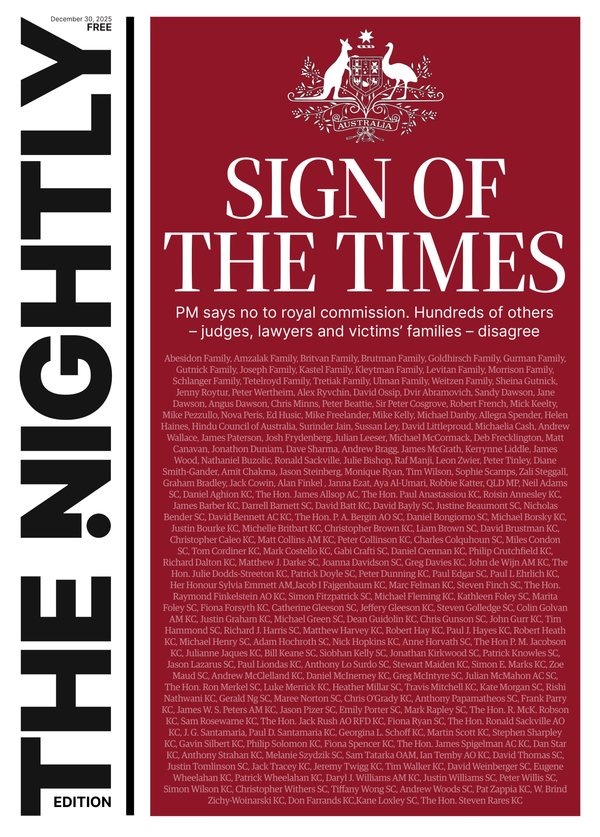The apartment building that shows why Australia has a housing problem

An apartment building complex being built in the Sydney suburb of Bondi Junction shows why Australia has a housing crisis.
The twin-tower, 16-storey project on Oxford St should be the perfect example of inner-city development. Close to a train line, bus routes, a large park, beaches, shops, a harbour, high-paying jobs and under-utilised schools, it would create dozens homes on land previously used for a rental car yard.
Even though there is no natural, cultural, historical or architectural heritage on the site in need of protection, the owner has to obtain approval not only from NSW planning regulators, but the Federal Government under the Environment Protection and Biodiversity Conservation Act, a law Environment Minister Murray Watt promised today to reform by the end of the year.
Sign up to The Nightly's newsletters.
Get the first look at the digital newspaper, curated daily stories and breaking headlines delivered to your inbox.
By continuing you agree to our Terms and Privacy Policy.The project’s other main impediment are the residents of Sydney’s eastern suburbs, who are notorious for fighting new housing despite living in one of Australia’s wealthiest regions. They include Darren Goodsir, the chief of staff to Sydney University Vice Chancellor Mark Scott and a former Sydney Morning Herald editor-in-chief.
“This development sets a precedent that favours profit-driven ventures over policies designed to promote inclusivity and affordability,” he wrote to the NSW government. “If the city continues to approve such projects, it risks fostering a housing market that caters exclusively to the wealthy, further alienating those struggling to afford stable living conditions.”
The consequences go far beyond one project. The average home price in the capital cities is now $1,034,806, a sum far beyond the reach of most school leavers or university graduates. Both main political parties acknowledge that without more housing, property will become even more expensive, exacerbating social inequality.
Winter shadow
A pro-housing movement known as Yimby, for yes in my back yard, argues the kind of claims made by Mr Goodsir and others are misleading. Building extra accommodation anywhere in a city helps lower prices, even if those new apartments or houses are expensive, because they trigger a chain reaction that eventually frees up cheaper homes, according to former Reserve Bank economist Peter Tulip.
New-housing opponents use rules to block developments in their neighbourhoods. Some 30,000 housing and other construction projects are awaiting approval under the federal Environment Protection law.
Opponents argue the Oxford St apartment towers are caught by the law because they will overlook Centennial Park, one of the city’s grandest parklands.
The buildings will, according to Mr Goodsir, “cast long shadows over key areas of the park ... potentially disrupting local biodiversity”. Fellow resident Genevieve Taylor argued “the national heritage significance of Centennial Park — a landscape of exceptional environmental, social, and historical value — cannot be overstated.”
The park’s official custodians do not agree. Greater Sydney Parklands told the government the buildings would shadow “a small area of the park” between 10am and 11am on one day in the middle of winter. Mr Goodsir declined to comment.
‘Self serving’
Nearby Woollahra Council — home to the city’s richest suburbs — is also fighting development. Mayor Sarah Dixson complained this week about a decision by the state to build a new train station and 10,000 homes in the suburb. Because two-bedroom apartments in the area cost $1.5 million to $2 million, Ms Dixson said they would be unaffordable for young people.
The Sydney Yimby group issued a scathing response. “Step 1,” it wrote on X. “Engineer a housing crisis by blocking new homes, making them massively unaffordable. Step 2: When somebody proposes building homes, hit them with ‘but they won’t be affordable!’ It’s just so unbelievably self serving.”
More people lived in Woollahra in the 1970s, according to NSW Premier Chris Minns. “Which is a window into culture we’re trying to kill in NSW,” he said in a speech Tuesday evening. “It’s that culture of no.”
Among the Nimby (not in my backyard) allies are the federal independent MPs known as teals. This week one of them, Nicolette Boele, who represents a seat on the north side of Sydney Harbour, complained the Nimby versus Yimby debate “reduces complex questions to a culture war” — and then cited one of the most common Nimby arguments: yes we support new housing, just not yet.
Leaving home
While local politicians reflect their electors’ Nimby priorities, state and national-level ministers must deal with housing shortages. On Monday the federal government pulled forward an subsidy for people buying their first home from January to October.
The scheme was originally restricted to 35,000 places and people who earn less than $125,000. Now there will be no income test or limit on places, a decision economists say will drive up demand for housing and prices — making the property market even more competitive.
“Why do governments of all political persuasions keep doing this?” asked independent economist Saul Eslake. “Because they know that a very large majority of Australian voters ... want governments to do things that keep house prices going up, preferably at a faster rate than incomes.”
The effect can be seen on where Australians choose to live. Sydney, Australia’s most expensive city, lost 41,086 residents in the 2023-24 financial year, many of them young men and women who gave up hope on building lives in their birthplace.

